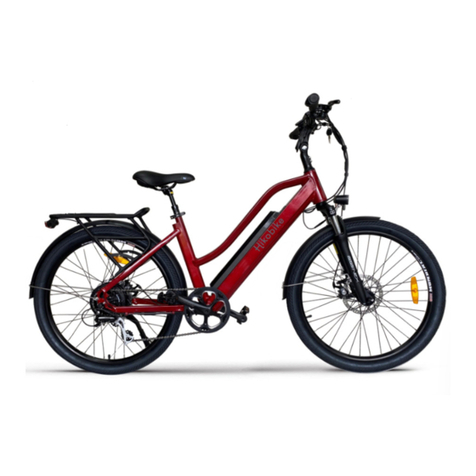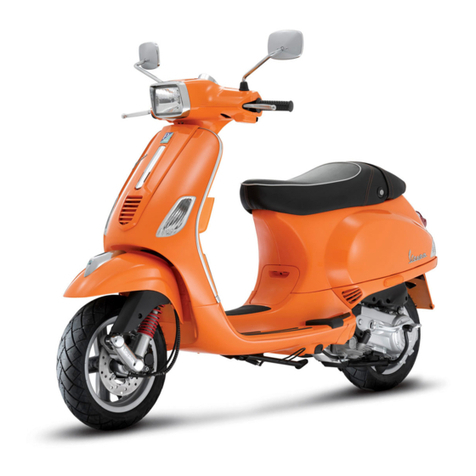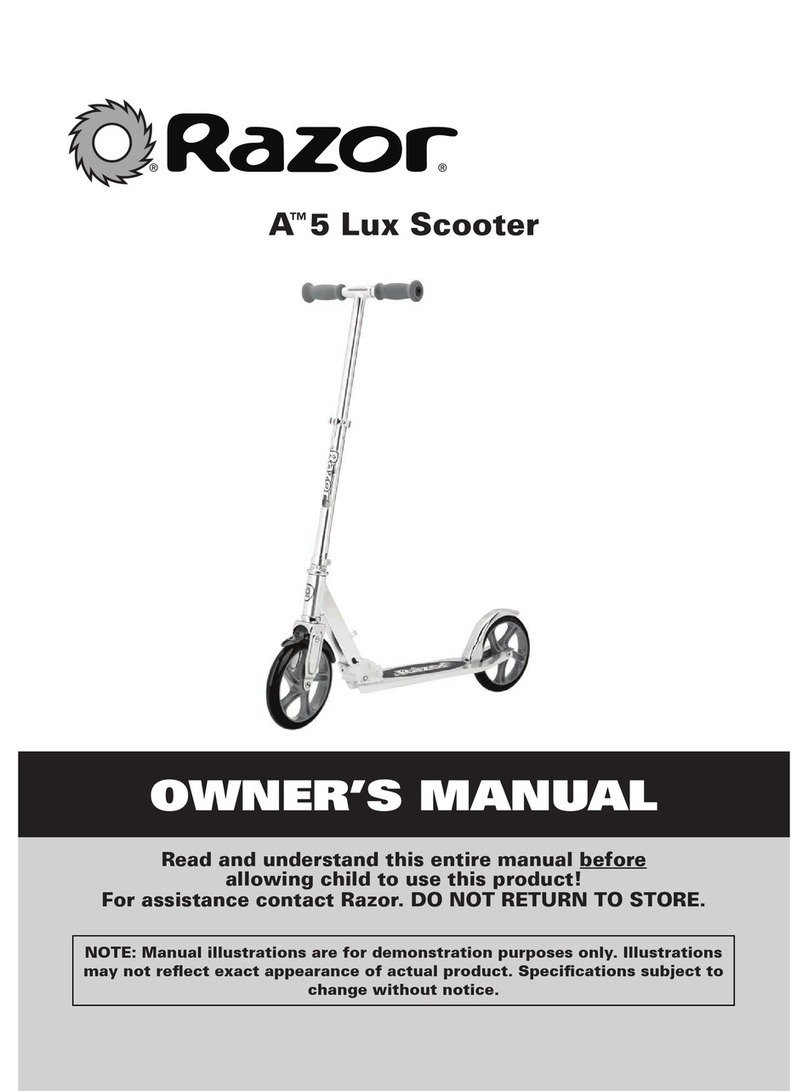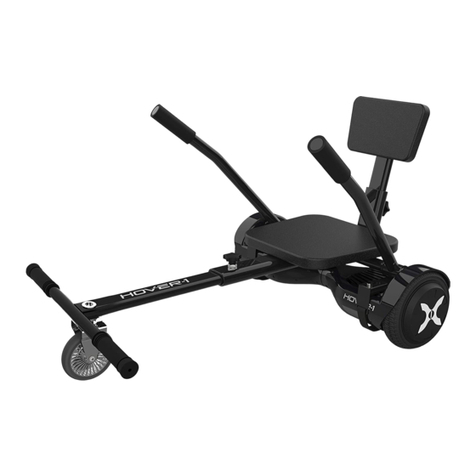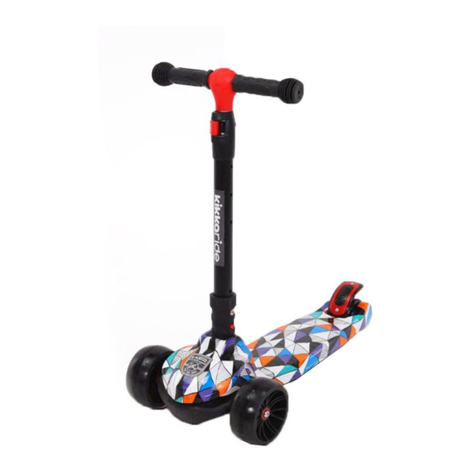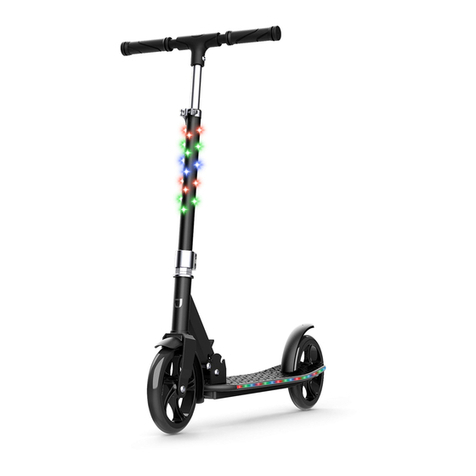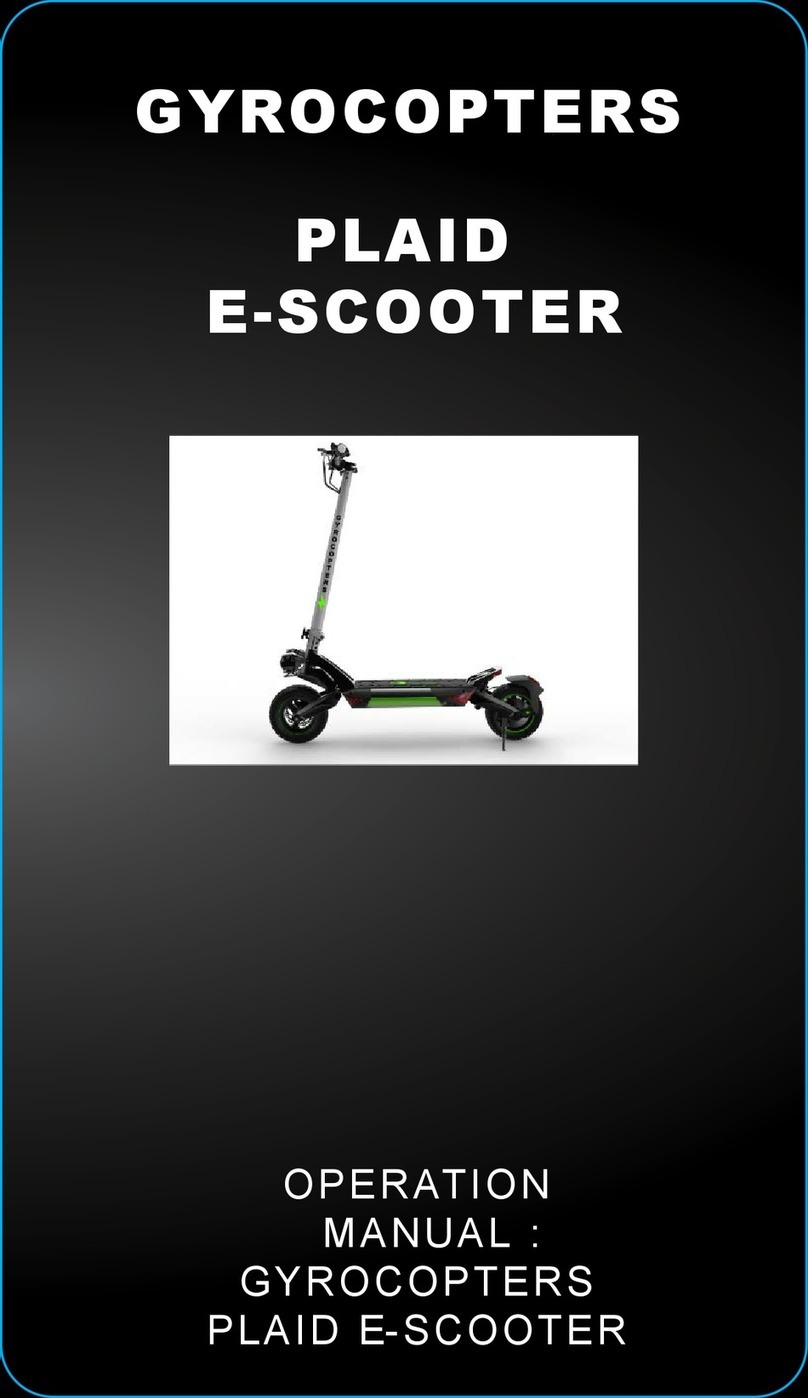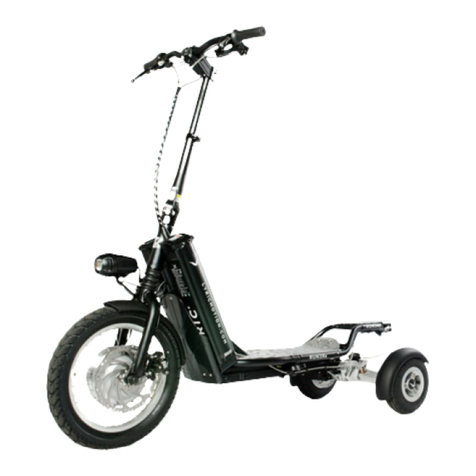Hikobike RANGLER User manual

PLEASE READ THIS GUIDE BEFORE RIDING YOUR EBIKE
Models: RANGLER / SPEEDSTER / ASCENT
USER GUIDE
1

CONTENTS:
ASSEMBLY / GENERAL PRECAUTIONS BEFORE RIDING
3
SPECIFICATIONS
3
BATTERY
4
BATTERY CHARGING
4
BATTERY STORAGE
5
INSTALLING AND REMOVING THE BATTERY
6
BATTERY WARNINGS
6
CONTROL PANEL AND LED DISPLAY C900E
7
QUICK START –RIDING THE BIKE and PRE-RIDE CHECK LIST
8
NORMAL OPERATION
9
DISPLAY SETTINGS
10
ERROR CODES
11
MAINTENANCE AND STORAGE
12
DO’S and DON’TS
13
WARRANTY
14
CONTACT
14
2

ASSEMBLY
The assembly of your HIKOBIKE must be performed and safety checked by a HIKOBIKE dealer or
bicycle mechanic. Assembly of the stem, handle bars, and tuning of the gears and brakes requires
expert bicycle mechanic knowledge.
GENERAL PRECAUTIONS BEFORE RIDING
Always wear a safety bicycle helmet when riding a HIKO electric bike
Observe the local rules for bicycles and e-bikes
Check Tyre Pressure (35-50psi), brakes, fasteners, and locking systems before commencing on a ride
HIKOBIKEs are designed for comfort for use on smooth gravel, dirt or paved surfaces. They are ideal
for maintained walking and biking tracks, but not for downhill or single-track mountain bike type use.
HIKOBIKEs are not designed for jumps or extreme riding conditions.
SPECIFICATIONS
Model RANGLER/ASCENT SPEEDSTER
Weight without battery
Maximum assist speed
Maximum load carrying
Motor
Display
Front Fork
Brakes
Derailleur
Tires
Battery
Samsung 500Wh with BMS / USB
25.5kgs
25.5kgs
45km/hr
45km/hr
130Kg
130Kg
300W DAPU
250Watt MID MAX motor
C900E Colour
C900E Colour
Suntour XCM
Suntour XCM
Tektro Hydraulic 180mm Disc
Tektro Hydraulic 180mm Disc
Shimano Deore 10 speed
Shimano Deore 10 speed
27.5 x 2.35
27.5 x 2.40
Weight
Weight
3.5Kgs
3.5Kgs
3

BATTERY
The HIKOBIKE come standard with a 48V Samsung or LG Li-Ion Battery with a built in Battery
Management system (BMS). The BMS is important component as it allows the charger to charge
the battery cells evenly, which will maximise the life expectancy and storage power of the battery.
HIKOBIKEs can be upgraded with larger capacity batteries according to availability. Your standard
charger for the standard battery can charge the larger batteries.
Contact your dealer to if you wish to purchase a larger battery.
BATTERY CHARGING
IMPORTANT: Use a Surge Protector with your battery charger to protect against spikes in
household voltage.
Charging time: approximately 3 -6 hours for 100% Charge
You can charge the battery either on or off the bike. When the battery is removed from the
frame, you can use the battery level indicator to check the battery level. To do this, press the
button on top of the battery - there are 4 LED light bars to display the state of charge. The more
LEDs that light up, the more battery charge you have available. When charging the battery on
the bike you can see the state of charge on the display.
Only charge the battery in temperatures between 10 - 30 deg C, in a dry and safe place. Do not
cover the battery during charging. If the battery is extremely cold, warm the battery in a warm
ambient room for a few hours before charging it.
To charge your battery follow these steps:
1. Plug the charger’s 3 pin plug into the Wall Socket / Surge Protector (which is OFF)
2. Plug the charger into the battery.
3. Then Turn ON the Wall Socket/ Surge Protector to turn ON the charger.
4. The Charger will show LED light: RED –Battery is being Charged. When the LED light
changes to Green the battery is fully charged.
5. Once charged, turn OFF or unplug the Charger from the Wall Socket. The battery can remain
plugged into the Charger if the Charger is turned OFF or unplugged from the Wall Socket.
The duration of a 500Wh battery while riding can range from 40 to 80 km depending on assist
level selected, rider input, and road conditions.
Charge your battery even after a fairly short ride. Small charge top ups do not affect battery life.
4

BATTERY STORAGE
Store your battery at dry temperatures between 15-25 deg C. Your battery likes the same
temperature you do.
When storing the battery for periods longer than 2 months, fully charge the battery and remove the
charger from the wall socket. The Battery has a 4 bar charge indicator on the battery pack. Push the
button to see how many bars light up. Try to keep the battery with at least 2 bars showing.
The Li-Ion Battery will slowly lose its charge over long storage intervals.
It is important to check and charge the battery at least every 3 months, and keep the battery
charged between 20% and 100% level.
Allowing the battery to fully discharge during long storage can harm your battery.
Never leave your battery fully discharged as it may cause permanent damage to the battery.
5

INSTALLING AND REMOVING THE BATTERY
The key is to secure the battery from theft and does not need to be in place to use the bike.
HIKOBIKEs are supplied with 2 keys when new. Please keep one in a safe place where you can
find it again –there are a multitude of key numbers so if you lose both keys you will find it a
serious inconvenience!
To remove the battery from the frame
The battery can be easily removed from the bike. It is quite heavy and can easily be dropped so
take great care
Place one hand under the upper part of the battery and turn the key anticlockwise
Keep your hand underneath the battery and hold it. With your other hand turn the turnbuckle
that is on the underside to release the battery
Lower the top of the battery, still holding it firmly and then remove it gently without letting it
slip out of your hands
If you are turning the key to unlock the battery, ensure you are holding onto the battery at the
same time.
To install the battery
insert the lower end of the battery into the bottom of the battery frame, with the top end of
the battery lower than the frame
Lift the upper end of the battery and click it firmly into the frame
Check that the battery is secure before removing your other supporting hand
The battery is then secure and you can remove the key if you wish.
BATTERY WARNINGS
The Li-Ion battery is one of the major components on the HIKOBIKE e-bike and great effort should
be taken to look after it.
•Always handle with great care. Do not drop or allow it to be struck.
•Do not take the battery casing apart or tamper with the battery.
•Keep it away from children.
•Keep it away from temperatures above 50 °C.
•Never allow a connection between the electrical contacts.
•Never spray it with a hose, immerse it or allow excess water on it.
If you suspect the battery is damaged or not working correctly, contact your dealer who can
have the battery checked and diagnosed using the built-in Battery Management System.
6

CONTROL PANEL AND LED DISPLAY C900E
The control panel by your left thumb has an ON OFF button, a SET button and up and down
arrow buttons.
When you press the ON button on the LED display the screen will light up.
❶Battery level
❷Lights are on / off
❸Bluetooth is on / off. Hold the SET and UP
buttons for 5 seconds to access USB
❹Current speed in bars
❺Current speed in KM/H or M/PH
❻Motor output
❼Trip: displays the user’s single riding
mileage. ODO: Total riding mileage
accumulated (this cannot be reset). Time:
time of single ride.
❽Eco or Sport mode
❾PAS: current level of assistance. 6KM:
walking mode. Hold the DOWN button for
two seconds to access.
7

QUICK START - RIDING THE BIKE
PRE-RIDE CHECKLIST
Please make sure the brake levers are fitted to the correct side of the handlebar for the
country before riding. In UK, NZ and Australia the left brake lever is for rear brake and the
right brake lever is for the front brake. In many other countries it is the other way: left for
front, right for rear.
•Check the tyres for any visible damage.
•Check tyre pressures are 40-50psi, 40Psi is usually best and adjust if necessary.
•Check for any loose nuts, bolts, or fixings.
•Check brake functions, cable tension, pad clearance, etc.
•Check all electronic functions are ok (functions detailed later in this manual).
•Check the reflectors are in place and the lights are working
Before riding off on the bike:
Press the ON button on the control panel
Check the battery capacity
Select the level of assist from 1- 5
Start pedalling to start the motor
Select the appropriate gear
For optimum battery life, try to avoid riding the e-bike until the battery is completely flat. Turn
off the Power Assist as soon as you notice the battery has lost power, pedal the bike home and
charge the battery as soon as possible.
TORQUE SENSOR
You will notice the harder you push down on the pedals the more power assist comes from the MID
Motor.
8

NORMAL OPERATION
Press and hold the ON button for 2 seconds to power on the display. Pressing and holding the ON
button again for 2 seconds will turn OFF the display. If the bike is not used after 5 minutes the
display will turn OFF automatically.
ASSIST MODE SELECTION
Press the up or down arrows to select the desired level of assistance from the motor. Level 1 is the
lowest and Level 5 is the highest. At Level 0 there will be no assist from the motor while pedalling.
STOPPING THE MOTOR
All the following will stop the motor:
Stopping pedalling
Pulling on either brake lever
Pressing the thumb throttle whilst pedalling
Pressing the down arrow to PAS 0
HEADLIGHT / REARLIGHT AND DISPLAY BACKLIGHT SWITCH
A quick press of the ON button will turn on the backlight of the display and the head and taillight.
Press the ON button to turn them off.
WALK ASSISTANCE 6KM/HR
Press and hold the (down) Button. The ebike will move at 6Km/hr and be in WALK mode. Once the
button is released the ebike will stop.
BATTERY CAPACITY INDICATOR
When the battery status is normal, a certain number of the battery LCD segments at the top left
of the screen will light up, according to the level of charge. A percentage charge figure shows
beside it. If the indicator shows the battery is very low the battery needs to be charged
immediately. It is not recommended to discharge the battery completely while riding as this can
decrease the overall life of the battery.
9

DISPLAY SETTINGS
Press and hold the SET button for 2 seconds to enter the main settings menus.
In the general set up screen:
1.1 Reset the trip meter –quick press SET to toggle between Y and N
1.2 Brightness for lights –default is 5
1.3 Speed limit is factory set at 45Kph
1.4 Wheel size is 27.5 –do not change this
1.5 Unit –toggle between MPH and KPH - move down to next screen using the double down arrow
1.6 Mode –quick press SET and toggle between ECO and SPORT. ECO will simply limit the amount of
power available to you
1.7 Password –engineer only
1.8 Assistance –default is 5
1.9 Exit –press set on this line and then on the next screen press Exit again to leave the settings
menu.
These settings are pre-set to enable you to make the best of your bike. However, more information
on programming options is available from your dealer.
Please note that in the UK there are laws prohibiting overriding certain settings and this will also
invalidate your warranty. Please speak to your dealer if you are unsure what these settings are.
10

ERROR Codes
Error Code
Error Description
Trouble Shooting
0
Normal
1
Current error or MOS damaged
Contact dealer
2
Throttle error
Check throttle connection
3
Motor no phase position
Contact dealer
4
Hall error
Contact dealer
5
Brake error (start detection)
Check the brakes sensors are not stuck on
6
Under voltage
Contact dealer
7
Motor stalling
Check battery or motor overheating
8
Communication controller receiving error
Check speed sensor
9
Communication display receiving error
Check connections to display
11

MAINTENANCE AND STORAGE
Dealer and Bicycle mechanic routine maintenance:
Your bicycle should be taken to a servicing dealer or bicycle mechanic after 250km of riding to
check the tension of the spokes. Then every 1000km for a general service and inspection. Failure
to do this can void your warranty due to unnecessary wear and tear.
User maintenance:
1. Oil the chain frequently using special bicycle lubricant (dry or wet). Apply the lube oil on the
chain by turning the pedals and dripping the lube oil on the chain as it moves past, and spin
for a few turns and change into all gears. It is easiest to do this on the bike stand or bike
carrier, with the wheels suspended off the ground. After applying the lube oil it is important
to clean off excess lube oil with a cloth. This removes old dirt that the new lube has
dislodged.
2. Keep tyre pressures within the tire recommendations; see tyres for max PSI inflation.
Normally 35-60psi gives a hard tyre pressure for efficient peddling and battery consumption.
3. Check brake disc pads for even wear patterns. If the brakes become noisy when applied,
take to a service bike shop to check to see if they need replacement.
4. Store your e-bike in a dry place and away from corrosive environments.
Torque Settings
All bolt torques should have been checked during the pre delivery inspection (PDI). If
you have done the final assembly yourself please check before you set off for the first
time.
a. Handlebar clamp bolts 8 Nm
b. Headset bolts 8 –10 Nm
c. Stem angle bolt 15 Nm
d. Quick release front & rear axle Common industry practice is resistance at lever
halfway through swing from open to fully closed.
e. Seat tube clamp nut Common industry practice is resistance at lever halfway
through swing from open to fully closed
f. Seat angle clamp bolt 22Nm
For reference specific bolts are tightened according to the recommended torques on PDI
With any other bolts, the torque depends on the diameter:
M4 2.5-4.0 Nm
M5 4.0-6.0 Nm
M6 6.0-7.5 Nm
12

DO’S AND DON’TS
Do treat your e-Bike like any bicycle you would want to last well… keep it stored somewhere
secure and away from the elements.
Don’t treat your e-Bike as a dirt-bike! The motor and battery are weatherproof, but not water-
tight. It is ok in rain, but not to ford streams, etc!
Never take your e-Bike on the beach as salt water and sand will drastically shorten the
lifespan of many of the e-bike’s components (motor, gears, wiring connections, etc).
Note: Your warranty is void if evidence of salt, sand, or water damage are present within the
components. Important: If you live very close to the sea you must keep your bike indoors
when not in use. This will save you heaps as your components will last longer.
Important: Your bike may arrive with the battery partially charged. You need to give it a full
charge before ANY use. Top your battery up after each use (lithium batteries prefer shallow
discharge).
Note: The LCD battery display bars will dip under full load (on hills, etc). This is normal as
running voltage drops under high load. To get an accurate battery reading, wait about 10 sec
after the motor is not in use.
Do take extra care on the road as you will be travelling faster than you normally do on a bike
and your bike is now power-assisted, so will behave differently.
13

WARRANTY
Before delivery to the customer, Hikobike e-bikes are checked to the BS EN 14764 standard for
defective materials and construction defects by a qualified bicycle mechanic.
The warranty is only applicable to the first owner of the e-bike. The rights are not transferable.
Warranty Periods
The warranty period is effective from the date of delivery to the customer.
Part
Warranty Period
Components
1 year
Third party component warranty conditions
for the relevant manufacturer also apply. The
warranty does not apply to parts that are
susceptible to wear and tear, such as tyres,
chains, brakes, cables, cassettes, derailleur
except if they are assembly or material
defects.
Motor, battery and other
electronic equipment
2 years
Frame
5 years
Invalidating the Warranty
This warranty will be invalidated in any of the following circumstances:
•The e-bike has been subject to damage due to use in competitions, jumping, downhill, or
trials.
•The e-bike has been ridden in places unsuited to electric bicycles, including rivers, streams,
sea or any water deeper than a few inches, on sand or beaches, or any other place clearly
unsuited to an e-bike.
•The e-bike has been involved in an accident.
•The e-bike has been operated in a careless or reckless fashion.
•The e-bike has been modified with non-original parts or altered from its original settings.
•The e-bike has been used for rental or any other commercial purposes.
Hikobike has the ultimate decision whether to acceptant a warranty claim and the option of repair,
replacement or reimbursement.
Warranty work should only be carried out by authorised Hikobike agents and does not cover the
any transport costs.
Hikobike accept no liability for damage to the e-bike or parts that have arisen from: incorrect tuning
of moving parts; the improper use of the e-bike; and the improper maintenance of the e-bike. This
includes damage as a result of untimely replacement of parts which suffer wear and tear.
Acceptance of any warranty claim does not imply an acceptance of any liability for any damages.
This warranty is in addition to the customer’s standard legal rights in New Zealand.

CONTACT
United Kingdom www.hikobike.co.uk
Email: [email protected]k
New Zealand www.hikobike.co.nz
Email: info@hikobike.co.nz
14
This manual suits for next models
2
Table of contents
Other Hikobike Scooter manuals
